Deng Lab
Our lab aims to develop breakthrough innovations in oral-maxillofacial reconstruction technologies and investigate the cross-system regulatory interplay between oral and systemic health.
Our research team has established extensive collaborations with research groups across multiple disciplines, including materials science, engineering, bioinformatics, life sciences, and artificial intelligence. Building upon these interdisciplinary partnerships, we have conducted systematic and in-depth research in the fields of bone defect repair, oral health rehabilitation, and data-AI-driven diagnostic solutions.
Our first major research thrust focuses on biomaterial-mediated bone defect repair. Understanding the biophysical properties of bone is critical for developing new therapeutic strategies and novel scaffold biomaterials for tissue engineering, as well as provides a basis for the therapeutic application of various biophysical stimuli to restore the physiological microenvironment of injured/diseased bone tissue, so as to facilitate its repair and regeneration. Our team has made significant progress in the therapeutic concept of "electrical microenvironment restoration to promote bone regeneration" (Fig.1a), with notable breakthroughs in the development of electroresponsive vertical bone augmentation technology for jaw defect repair.
Furthermore, our team is committed to analyzing the various mechanisms by which biomimetic electrical microenvironments promote bone regeneration. We reported that the biomimetic electrical microenvironment could significantly enhance the M2 polarization of macrophages, as well as activate the PI3K-Akt signaling pathway in macrophages to enhance their pro-angiogenic functions, thereby facilitating angiogenesis during subsequent bone regeneration (Fig.1b).
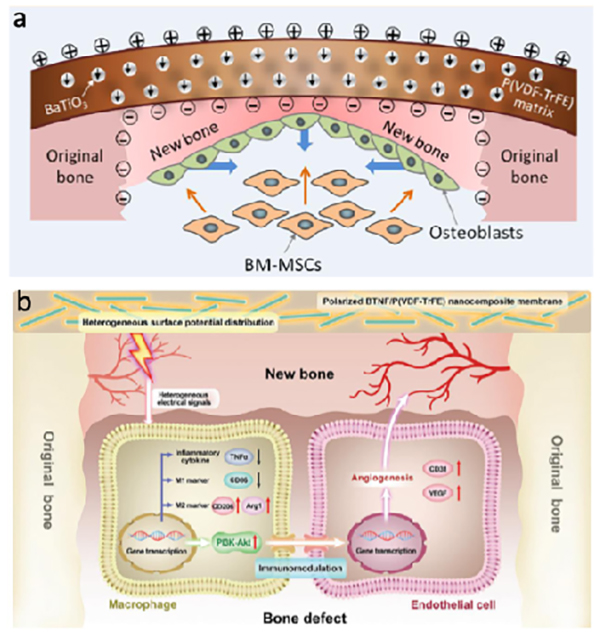
Fig.1 (a) Illustration of the biomimetic electrical microenvironment created by BTONP/P(VDF-TrFE) nanocomposite membranes that promote bone defect repair. (b) Schematic illustration of the heterogeneous biomimetic electrical microenvironment that enhances osteogenesis by inducing M2 polarization and the pro-angiogenic functions of macrophages
Our research also focuses on the epigenetic mechanisms that regulate local immune homeostasis in periodontal tissues and the impact of localized periodontal inflammation on systemic diseases. We identified a pro-inflammatory secretory neutrophil subset linked to periodontitis and found that the OTUD1-SEC23B-CD9/CD47 signaling pathway plays a crucial role in maintaining periodontal immune homeostasis. These provide new molecular targets, as well as fresh insights for developing prevention and treatment strategies for periodontitis (Fig.2a).
We also initiated a new paradigm shift in understanding the pathological mechanisms of periodontitis, whereby the "local inflammation-bone marrow hematopoietic reprogramming" immunoregulatory axis synergizes with the "pathogen-direct target organ invasion" infection dissemination axis (Fig.2b). It was demonstrated that periodontal intervention can bidirectionally modulate myeloid hematopoietic homeostasis while concurrently blocking pathogenic dissemination. This thus provides the basis for a dual-target therapeutic strategy aimed at both the “immune” and “infection” dimensions for preventing and treating co-morbid conditions.
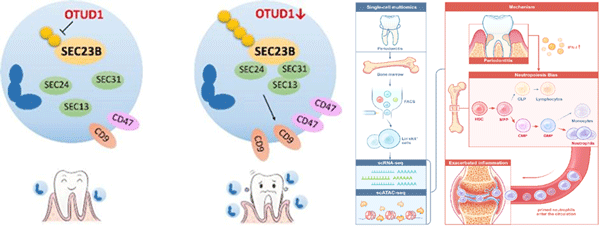
a b
Fig.2 (a) The pivotal role of the OTUD1-SEC23B-CD9/CD47 signaling pathway in maintaining periodontal immune homeostasis. (b) Periodontitis aggravates arthritis through an IFN-I-mediated neutropoiesis bias
The third major research thrust centers on the development of intelligent diagnostic models for oral diseases. Our team addresses key challenges in dental image segmentation and lesion detection by integrating domain-specific knowledge bases with advanced task decomposition methods grounded in tool learning and human-AI collaboration. We have completed the first clinical trial in China for an AI-based dental diagnostic software, obtained the nation’s first Class III medical device registration certificate in the field of dental AI, and have also led the formulation of a national group standard for AI-assisted caries detection (Fig.3). These achievements thus established a full innovation pipeline spanning basic research, clinical validation, translational application, regulatory approval, and standards development — thereby paving the way for effective AI deployment in complex diagnostic workflows.
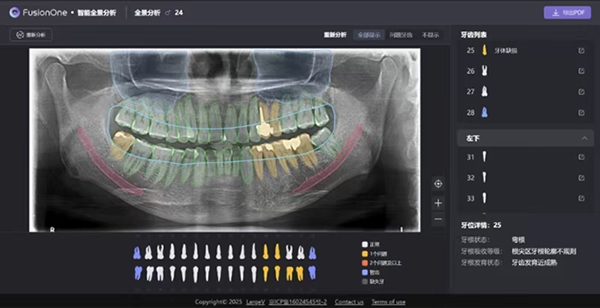
Fig.3 AI-assisted radiographic caries detection with region highlighting
DIRECTOR
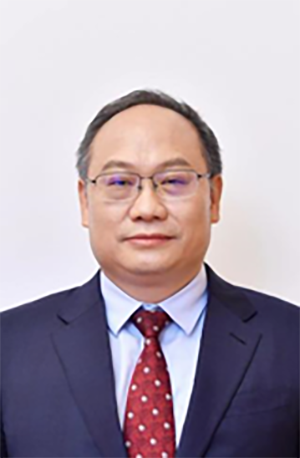
Xuliang Deng, DDS, PhD
Professor, Chief Physician
Principal Investigator
kqdengxuliang@bjmu.edu.cn | +86-10-82195584
Dr. Xuliang Deng is a professor and president of the Peking University School and Hospital of Stomatology, executive deputy director of the Department of Biomedical Engineering of Peking University, director of the National Center of Stomatology, and an academician of the Chinese Academy of Medical Sciences. He was awarded the National Science Fund for Distinguished Young Scholars, has been designated as the person in charge of the Creative Research Groups of the NSFC, which entitles him to receive a special government allowance from the State Council. In recent years, he has presided over more than 30 national and provincial scientific research projects and has published more than 250 papers in several internationally renowned journals including Science and Nature Materials. Of these, 160 are SCI-indexed publications, which have been cited more than 4500 times. To date, he has obtained 67 authorized national invention patents and 4 international invention patents. The series of new dental and jaw restoration materials developed by him have obtained 4 Class III medical device registration certificates of the National Medical Products Administration, and have been promoted and applied in more than 10 million cases in more than 1500 medical institutions at home and abroad. Additionally, he has also been awarded the National Innovation First Award, the title of National Outstanding Scientist, the first prize of the Ministry of Education award for scientific and technological progress, the first prize of the Chinese Stomatological Association award for Science and Technology, the first prize of the Huaxia Medical Science and Technology Award, the highest award of the National Subversive Technology Innovation Competition, and the Guanghua Engineering Science and Technology Youth Award.
RESEARCH AREAS
Biomaterials and Bone Regeneration
We have been working for several years on the controllable design and key property tuning of magnetic, electrical, acoustic, optical and thermal biophysical stimuli-responsive materials. Our latest work focuses on the application of oxidative stress modulation strategies in bone defect repair. Reactive oxygen species (ROS) and reactive nitrogen species (RNS) are often overproduced after bone injury, causing the oxidative stress and apoptosis of bone-derived mesenchymal stem cells (BMSCs). Hence, there is a dire need to develop guided bone regeneration (GBR) membranes with strong anti-oxidative properties to facilitate bone regeneration. We have carried out a landmark study in the bone tissue engineering field involving the innovative fabrication of sequential bridging MXene (SBM) films that exhibit high strength and superior osteoinductivity, which have demonstrated enormous potential for clinical bone repair. The underlying pro-osteogenic mechanism involving anti-inflammatory and immunomodulatory cascade processes is highly innovative, and can provide a new framework for designing safe and efficient bone regeneration materials. A series of publications highlight our work on improving the efficacy of bone regeneration.
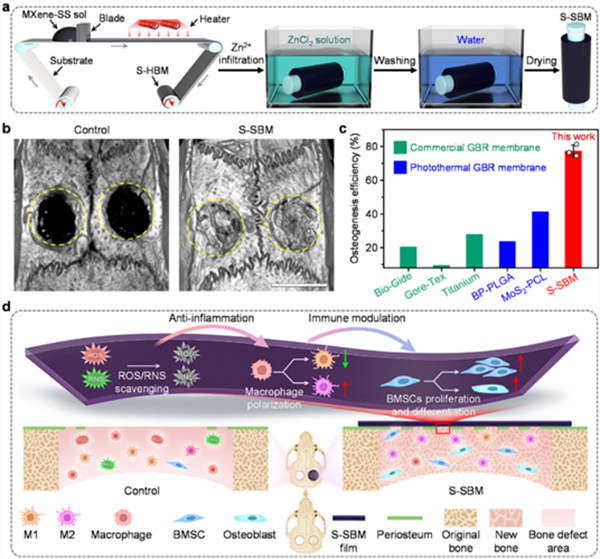
Fig.4 (a) Fabrication process of SBM films. (b) Micro-computed tomography images of rat calvarial defect areas after bone repair for 8 weeks in the control and SBM groups. Scale bar, 5 mm. (c) Osteogenic efficacy of SBM films compared with commercial GBR membranes and previously reported photothermal GBR membranes. (d) Schematic illustration of the pro-osteogenic mechanisms of SBM films
Bidirectional Interactions Between Oral and Systemic Health
Our team actively investigates the complex, bidirectional interactions between oral and systemic health, focusing on the role of inflammation, immune modulation, and microbiota. We have conducted multi-center randomized controlled trials demonstrating that periodontal therapy improves systemic outcomes in patients with co-morbidities such as rheumatoid arthritis. Parallel studies also explore how systemic diseases and aging-related epigenetic changes impact periodontal status. Additionally, our research group also employs oral microbiome profiling to uncover links with chronic inflammatory diseases, aiming to identify predictive biomarkers and shared pathogenic mechanisms. This body of work thus bridges clinical dentistry and systemic medicine, supporting an integrative approach to diagnosis and prevention across multiple disciplines.
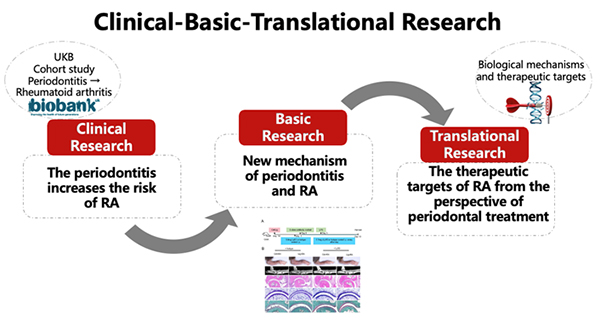
Fig.5 Schematic illustration of the full-chain research framework linking clinical observations, mechanistic studies and translational applications in periodontitis–systemic conditions interactive research
Oral Health Data Governance and Platform Development
Our team has established an integrated platform for oral healthcare data collection, standardization, and utilization. Multi-source data fusion systems have been designed, which contributed to the creation of China's first clinical trial system for dental AI software. This work supports clinical decision-making and research by enabling secure, structured, and scalable dental data utilization. This platform has been adopted by multiple national demonstration units and serves as a backbone for dental informatics standardization.
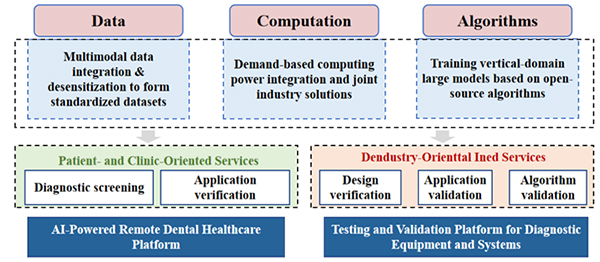
Fig.6 Architecture of an AI-driven dental health platform integrating data, computation, and algorithms to support clinical services and medical device validation
RECENT PUBLICATIONS
Scalable ultrastrong MXene films with superior osteogenesis
Nature, 2024, 634(8036): 1103-1110
Multiscale engineered artificial tooth enamel
Science,2022,375(6580):551
Graphene oxide bulk material reinforced by heterophase platelets with multiscale interface crosslinking
Nature Materials,2022,21(10):1121
In situ activation of flexible magnetoelectric membrane enhances bone defect repair
Nat Commun. 2023;14(1):4091
Charged substrate treatment enhances T cell mediated cancer immunotherapy
Nat Commun. 2025, 16(1):1585
The mechanism of dentine hypersensitivity: stimuli-induced directional cation transport through dentinal tubules
Nano Research,2022
Optimizing the electrical microenvironment provided by 3D micropillar topography on a piezoelectric BaTiO? substrate to enhance osseointegration
Advanced Materials, 2024
Spatiotemporal molecular architecture of lineage allocation and cellular organization in tooth morphogenesis
Advanced Science, 2024
Manipulation of surface electrical charge on nanocomposite membranes confers wide spectrum bactericidal effects and promotes tissue regeneration
Advanced Functional Materials, 2024, 34
Multifunctional ptcute nanosheets with strong ros scavenging and ros-independent antibacterial properties promote diabetic wound healing
Advanced Materials, 2024, 36
Superior synergistic osteogenesis of mxene-based hydrogel through supersensitive drug release at mild heat
Advanced Functional Materials, 2024, 34
The deubiquitinase otud1 suppresses secretory neutrophil polarization and ameliorates immunopathology of periodontitis
Advanced Science, 2023: 2303207
Manipulation of Heterogeneous Surface Electric Potential Promotes Osteogenesis by Strengthening RGD Peptide Binding and Cellular Mechanosensing
Advanced Materials. 2023;35(24):e2209769
Mutant RIG-I enhances cancer-related inflammation through activation of circRIG-I signaling
Nature Communications, 2022, 13(1)
Pyro-catalysis for tooth whitening via oral temperature fluctuation
Nature Communications,2022,13(1)
Chirality Controls Mesenchymal Stem Cell Lineage Diversification through Mechanoresponses
Advanced Materials, 2019, 31(16): 1900582
Chirality bias tissue homeostasis by manipulating immunological response
Advanced Materials. 2021
An Amorphous Peri-Implant Ligament with Combined Osteointegration and Energy-Dissipation
Advanced Materials. 2021,33(45):2103727
Nanocomposite Membranes Enhance Bone Regeneration Through Restoring Physiological Electric Microenvironment
Acs Nano, 10(8), pp7279-7286, 2016
Dynamically modulated gating process of nanoporous membrane at sub-2-nm speed
Matter,2022,5(1):281-290
TEAM
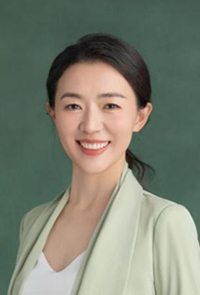
Mingming Xu
Lab Specialist
anniemmx@126.com
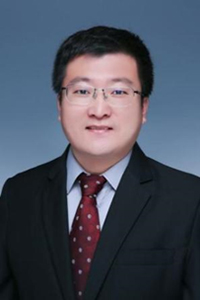
Xuehui Zhang
Lab Specialist
zhangxuehui@bjmu.edu.cn
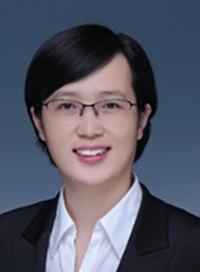
Ying Huang
Lab Specialist
hying031129@163.com
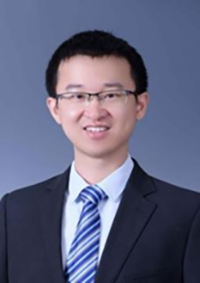
Xinyu Liu
Lab Specialist
liuxinyu@hsc.pku.edu.cn

Yang Liu
Lab Specialist
yang.liu@hsc.pku.edu.cn
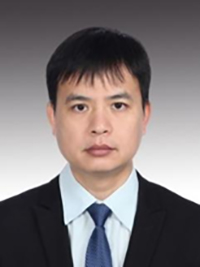
Jinqi Wei
Lab Specialist
weijinqi03@163.com

Wenwen Liu
Lab Specialist
veromcaliu@126.com
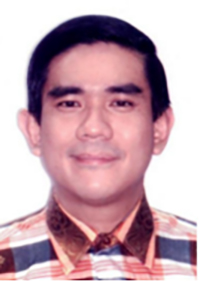
Heng Boonchin
Lab Specialist
hengboonchin@bjmu.edu.cn

Ying He
Lab Specialist
heying@bjmu.edu.cn
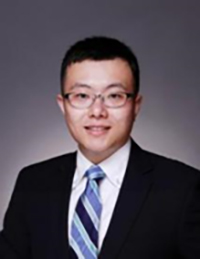
Yunyang Bai
Lab Specialist
baiyunyang@bjmu.edu.cn

Ying Chen
Lab Specialist
chenying1@pkuss.bjmu.edu.cn

Yaru Guo
Lab Specialist
kqguoyaru@bjmu.edu.cn

Xiaona Zheng
Lab Specialist
zhengxiaona@pku.edu.cn
CONTACT
Xuliang Deng
kqdengxuliang@bjmu.edu.cn
+86-10-82195584
Peking University School and Hospital of Stomatology,
No.22 Zhongguancun South Avenue,
Haidian District, Beijing 100081, PR China
last text: Hu Wenjie lab (Periodontology and Implantology Research Group)
next text: Yu Guangyan






